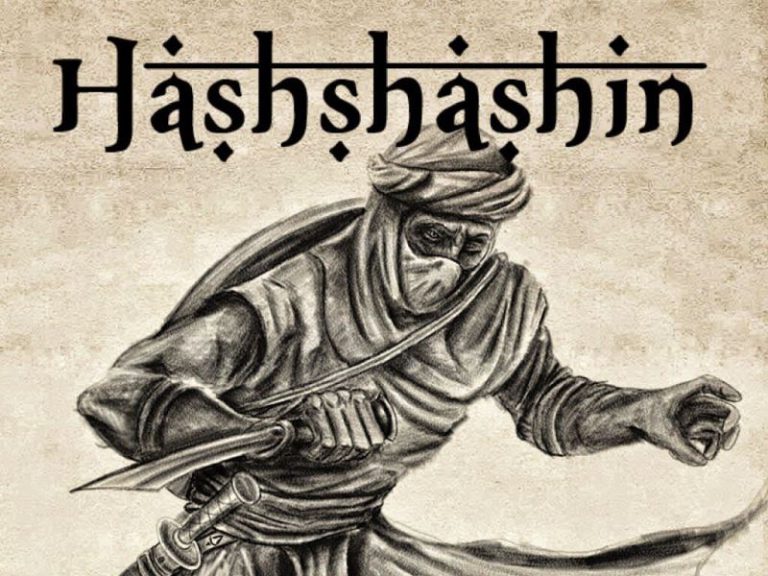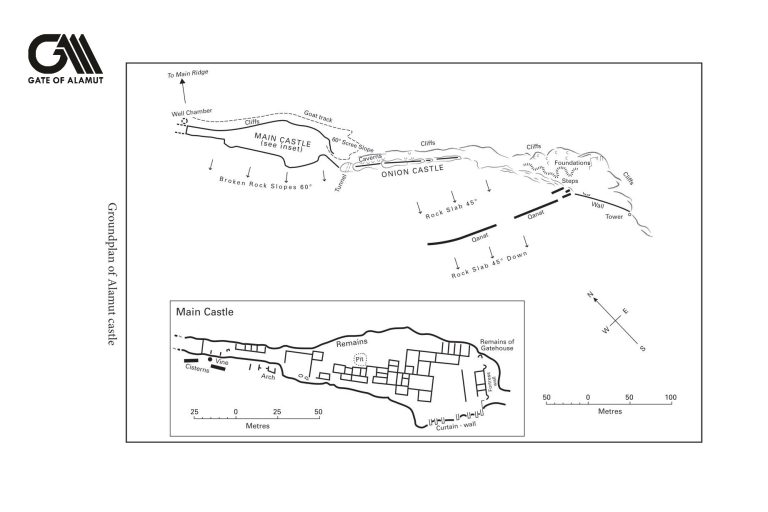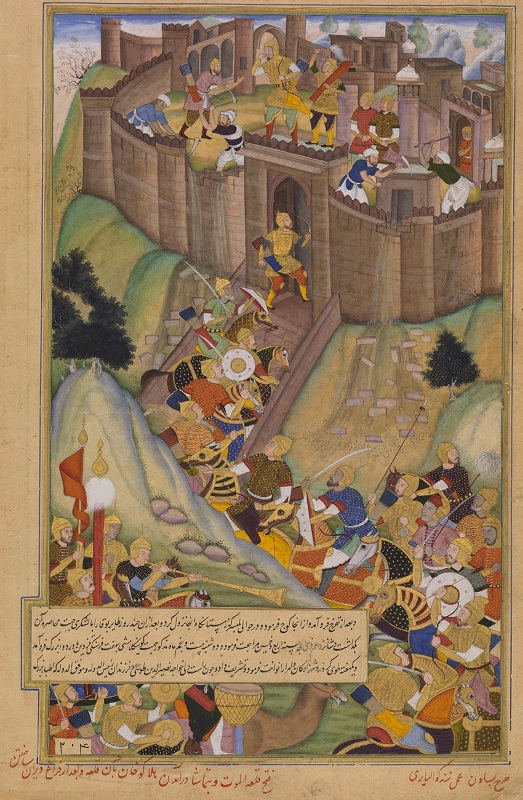Introduction
To know about the Alamut Castle history, I need to first explain the meaning of the word “Alamut”.
Alamut (Persian: الموت) in old Persian means “The nest of the Eagle”. It derives from two different ancient words in Farsi. “Ale” meaning “nest” and “Amoot” meaning “eagle”.
This is a ruined mountain fortress located in Alamut Valley in the south Caspian province of Qazvin. Alamut Castle is 110 kilometers from Qazvin and this town in its turn is 150 kilometers from Tehran.
With a professional, law-abiding driver, it will take approximately 3 hours from Qazvin to Alamut Castle.
Hasan Sabbah took over Alamut Castle in 1090 AD in favor of Ismaili Nizari’s invitation (Da’va – Arabic: دعوة)
The Mongol Khan named Hulakoo took down Alamut Castle in 1256. Until then, this castle served as the headquarters of the Nizari Ismaili state in Persia and Syria. This state included over 250 castles, towers, and watch points in the two territories.
60 fortifications in Alamut Valley, 50 fortifications in other regions of Iran and 140 of them in Syria, were all among the castles and strongholds of the Assassins in two countries.
Alamut, which is the most famous of these strongholds, was kind of impregnable to any military attack. It was fabled for its heavenly gardens, library and laboratories. It seems that philosophers, scientists and theologists could debate in intellectual freedom.
The stronghold survived adversaries including the Seljuq and Khwarezmian empires. In 1256, Rukn al-Din Khurshah (Persian: رکن الدین خورشاه) surrendered the fortress to the invading Mongols.
The Mongolians destroyed everything to the soil after putting on fire everything they were able to. The famous library of Alamut Castle was among the burnt sections.
Some 20 years later, Ismailis recaptured the castle, but it was never a long period of overtaking.

Alamut Castle after the Ismailis
Safavid dynasty in Iran had a role in Alamut Castle history, as well.
Late in the 17th and 18th centuries, when Safavid ruled in Iran, the ruins of Alamut Castle turned into a far prison. A political prison where the government kept the VIP’s while in jail. Most probably in that time, some construction happened in this castle.
Approximately 20 years ago (in 2003), the Iranian government started archeology operations in Alamut Castle. But this was not the first time tourists were able to visit and locate this castle.
The first visit to Alamut Valley was in 1832 by the British army people.
Later in 1838, the same people were able to reach Alamut Castle.
Freya Stark paid her visit to Alamut Castle in 1930.

Origins and Name
Ismailism is a sect of Shiite Islam But it was not Ismailis who built Alamut Castle. The castle was there 225 years before Hasan Sabah took the power.
In 865 AD, a Justanid ruler of Deylam named Wahsudan ibn Marzuban, a follower of Zeydi Shi’ism built Alamut Castle.
During a hunting trip, he witnessed a soaring eagle circling around a high rock. He realized the tactical advantage of this location and he chose the site for the construction of Ale Amoot i.e. the nest of the eagle.
Alamut remained under Justanid’s control until the arrival of Hasan Sabbah to the castle in 1090 AD. This was the start of the Alamut period in Nizari Isma’ili history.
Hasan Sabbah was the first ruler of Alamut Castle. He was not an Imam but a da’i (in Arabic: داعی), someone who invites.
He ruled in Alamut from 1090 to 1124.
Kiya Buzurg Umid was the second da’i of Ismailis in Alamut from 1124 to 1138.
Next da’i was Muhammad ibn Kiya Buzurg Umid from 1138 to 1162.
Then it was the Imams themselves who ruled at Alamut Castle.
The list of the Imam-Khalifates in Alamut Castle:
Hasan Ala Dhikrihi al-Salam (امام حسن علی ذکره السلام) (1162-1166)
Nur al-Din Muhammad (امام نور الدین محمد) (1166 – 1210)
Jalal al-Din Hasan (امام جلال الدین حسن) (1210 – 1221)
Al al-Din Muhammad (امام علاء الدین محمد) (1221 – 1255)
Rukn al-Din Khurshah (امام رکن الدین خورشاه) (1255 – 1256)

History of Ismailis or the Assassins
After the death of Imam Al-Mostansir in Egypt, there was a dispute between the two sons. Nizar and Al-Mosta’ali.
Al-Mosta’ali won the race with the help of the Vazir while Nizar had to flee away to save his life.
Hasan Sabah who believed Nizar was the legitimate successor, announced himself a da’i for Nizar in Persia.
The Ismailis and other occupied people of Iran held shared resentment and hatred for the ruling Seljuqs.
Seljuqs’ religion was Sunnit. From the beginning of the history of Islam, Shi’ites and Sunnites did not like each other. Each side believed the legitimacy of the succession of the prophet belongs to them.
Alamut Castle history is full of incidents where Ismailis or the Assassins had to fight with Seljuq and the Mongols in Persia.
Thus, the Sunni Sejuq did not spare any mercy to the Shi’ite Ismailis who sheltered in Alamut Valley.

Capture of Alamut
By 1090 AD, the Seljuq vizier Nizam al-Mulk had already given orders for Hassan’s arrest and therefore Hasan was living in hiding in the northern town of Qazvin. There is another theory that he was hiding in Deylaman county, close to Caspian. No matter where he was hiding, he made his way to Alamut Castle in disguise as a teacher.
From some time ago, Hasan was planning to capture Alamut Castle. Alamut fortress was surrounded by a fertile valley whose inhabitants were mainly fellow Shi’I I Muslims. Hasan Sabah needed and utilized their support to gain Alamut Castle and his power.
This castle which seemingly did not operate as a strong military base, was ruled (and owned) by Mahdi, a Zandi ruler. He was in close and permanent contact with the central government in Qazvin i.e. the Seljuk Turks.
Alamut Castle from the beginning up to now, has always been under construction and reconstruction. Some walls may fall, and some new designs and plans for the castle were needed. So, construction workers were always there in this castle.
Hasan with the help of the deputy of Mahdi (the lord of the caslte), had sent some soldiers in disguise of construction workers to the castle.
The deputy was waiting for Hasan Sabbah to announce his identity so that he can take power in favor of him.
In the meantime, some villagers in Gazorkhan were already joined to Hasan’s invitation to the Nizari Ismaili religion. Some Ismailis from other villages were settled in Gazorkhan and Shotorkhan, too. They were waiting for the day to come and Hasan Sabbah announces his capture of the Alamut Castle.

The Day of Alamut Castle Capture
Upon Mahdi’s return from Qazivn in the summer of 1090, he noticed several new servants and guards employed in Alamut Castle. His deputy explained that illness had taken many of the castle’s workers and it was fortunate that other labourers were found from the neighbouring villages. Worried about the associations of these workers, Mahdi ordered his deputy to arrest anyone with connections to the Ismailis.
Mahdi’s suspicions were confirmed when Hassan Sabah finally approached him (as the lord of the fortress). He then revealed his true identity and declared that the castle now belonged to him. Mahdi was allowed to exit the castle freely. Before leaving, however, Mahdi was given a draft of 3,000 gold dinars as payment for the fortress. The draft was payable by a Seljuq officer in service for the Ismailis. His name was Ra’is Muzaffar and he honoured the payment in full.


Construction and Intelectual Development
With Alamut castle now in his possession, Hasan began a complete re-fortification of the complex. By enhancing the walls and construction of storage facilities, the Alamut fortress was to act as a self-sustaining stronghold during major confrontations.
When the Mongols invaded the fortress, Juwayni was astonished to see stored countless supplies in perfect condition to withstand a possible siege.
Next Hassan Sabah took on the task of irrigating the surrounding villages of the Alamut Valley. The land at the valley’s floor was arable land, allowing for the cultivation of dry crops including barley, wheat and rice.
The land of Alamut Valley was terraced under Hassan Sabah’s direction.
Apparently, the astonishing library of Alamut castle was instructed during Hasan Sabah.

The Mongol invasion and collapse of the Nizari Ismaili state
The Mongol invasion of Islamic lands of Persia and West Asia could not come to a result without ruining the ardent Nizari Ismaili state.
Only after their destruction could the invading Mongols proceed to remove the Abbasid caliph from Baghdad and advance their conquest westward.
The first Mongol attack on the Ismailis came in April 1253 AD. Girdkuh was sieged some months before Alamut Castle.
At the time the Imam of the Ismailis was Rukn al-Din Khurshah. But he was not a strong opposition to the Mongol prince, Hulaku Khan. He made some gestures like removing towers and battlements in Alamut, Maymundiz and Lambesar.
Rukn al-Din descended from Maymundiz and surrendered to Hulaku Khan. Then he had to send a message of surrender to all the castles in Alamut Valley.
Muqaddam al-Din was the lord of Alamut Castle when the Mongolian troops were there.
He followed the message of Rukn al-Din and surrendered Alamut Castle after only 3 months. The Mongol Army entered Alamut and began its demolition.
Despite many cooperations that Imam Rukn al-Din had with the Mongols in the surrender of the Casltes in Alamut Valley, he was soon killed by them.
This post was all about the history of Alamut Castle. If you are interested in material about the geography and architecture of Alamut Castle, please read the following post:
Are you interested to book a tour with me and get to know all about Alamut Castle history? You can simply touch the email or whatsapp icon at the bottom of this page.
#alamut #alamout #alamot #ale_amut #ale_amoot #alamut_trip #alamut_tour #alamut_voyage #alamut_tours #alamut_castle #alamut_castles #alamut_history #alamut_fortress #alamut_valley #alamut_valley_tour #tour_to_alamut_valley #tour_to_alamut_castle #alamut_castle_tour #alamut_valley_guide #alamut_valley_local_guide #alamut_valley_history #assassins_history #assassins_history_iran #assassins_history_persia #castles_of_assassins #castles_of_assassins_iran #castles_of_assassins_persia #castles_of_assassins_history #history_of_assassins_iran #hashashin_persia #hashashin_order #hashashin_history #hashashin_assassins #best_alamut_guide #lambesar_castle_alamut #lamiasar_castle_alamut #lamisar_castle_alamut

